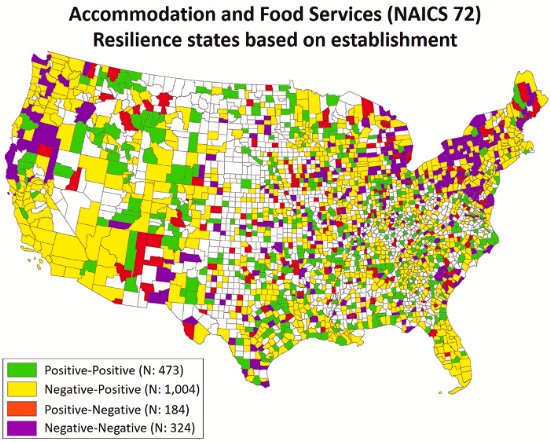
Classification of Accommodation and Food Services (NAICS 72) resilience
based on establishments by county within the contiguous U.S.
Logan, Utah, November 10, 2022 - Resilience requires the ability to absorb, adapt, and recover when circumstances have changed. And the resilience of individuals, businesses, and entire industries was put to the test during the COVID-19 pandemic. This is certainly true in the outdoor recreation tourism industries. But how can you quantify how resilient an industry is? Is there a way to visualize where the geographic areas of the country with high resilience, as well as other areas where resilience is lacking?
Recently, Eunjung Yang, a post-doctoral research associate with the Institute of Outdoor Recreation and Tourism (IORT), set out to answer these questions and quantify the short- and long-term impacts of the COVID-19 pandemic on the outdoor recreation and tourism industries within the U.S. Yang, along with Dr. Jordan Smith, Director of the Institute, quickly found the data and methods used to quantify resilience in previous research failed when applied to long-lasting and global impacts like pandemics. Yang and Smith went on to develop their own method for quantifying the resilience of the outdoor recreation and tourism industries. Their method uses data on growth rates in employment, wages, and number of establishments, and also differentiates between short- and long-term resilience.
Using the method, the researchers were able to classify every county across the country by the extent to which they adapted and rebounded from the impacts of the pandemic. The results, such as the figure below, allow outdoor recreation and tourism planners as well as policy makers to quickly see how the counties in which they work compare to neighboring areas. Importantly, the analyses also provide state and federal agencies with insights into where policy interventions, such as relief programs targeted at restaurants or hotels, are needed the most.
The research team believes their new method, which recently appeared in the journal Tourism Management, can be used to diagnose and monitor industry resilience for the purposes of developing targeted policies, programs, and promotion efforts that facilitate more localized response efforts. “The resilience of the outdoor recreation and tourism industries varies a lot across the country,” said Dr. Yang, “This work provides simple visual representations of that resilience. And it will help policy interventions be targeted, and ideally more effective, in the areas where they are needed most.”

